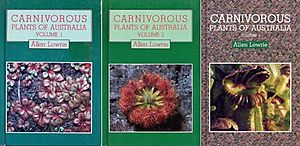Carnivorous Plants of Australia facts for kids

Covers of the three hardback volumes, showing Drosera species and Cephalotus
|
|
| Author | Allen Lowrie |
|---|---|
| Language | English |
| Publisher | University of Western Australia Press |
|
Publication date
|
1987 (Volume 1) 1989 (Volume 2) 1998 (Volume 3) |
| Media type | Print (hardcover, softcover; Volume 3 hardcover only) |
| Pages | xxvi + 202 (Volume 1) xxxviii + 202 (Volume 2) 288 (Volume 3) |
| ISBN | 0855642548 (Volume 1) 0855642998 (Volume 2) 1875560599 (Volume 3) |
| OCLC | 17554752 |
Carnivorous Plants of Australia is a series of three books about amazing carnivorous plants. These plants are special because they catch and eat insects! The books were written by Allen Lowrie. They were published in 1987, 1989, and 1998. The University of Western Australia Press released them.
Later, in 2013, Allen Lowrie published a brand new, updated version. It's called Carnivorous Plants of Australia Magnum Opus.
Contents
What's Inside the Books?
These books are packed with details about Australia's unique carnivorous plants.
Volume 1: Tuberous Sundews
The first book is all about Drosera plants. These are also known as sundews. This volume focuses on a special type called tuberous sundews.
Volume 2: Pygmy Sundews and More
The second book mainly covers pygmy sundews. These are tiny sundews. It also includes a few tuberous sundews that were discovered after the first book came out. Plus, it features two other sundew types: D. glanduligera and D. hamiltonii.
Volume 3: All the Rest!
The final book finishes up the sundew story. It covers all the other sundews found in Australia. But that's not all! This volume also introduces other cool carnivorous plants. These include Aldrovanda, Byblis, Cephalotus, Nepenthes, and Utricularia (also known as bladderworts).
How Each Plant is Shown
For every plant species, the books dedicate four pages.
- One page has a detailed description of the plant.
- Another page shows a beautiful drawing made by the author.
- A third page has a map. This map shows where the plant grows in Australia.
- The last page features colorful photos. These photos show the plant in its natural home and close-ups of its flowers.
What Did Reviewers Think?
People who read and reviewed the books had lots to say!
Review of Volume 1
Martin Cheek reviewed the first book in 1988. He thought the book was really good.
- He liked that each plant was clearly described.
- He praised the drawings, saying they were "superb" and much better than other books.
- The distribution maps were also much better, according to him.
- He loved the "outstanding color plates" (photos) showing the plants and their flowers.
Cheek did find a few small errors. But he still said the book was "essential reading." He called it the main guide for Australian tuberous sundews.
Review of Volume 2
Donald Schnell reviewed the second book in 1990.
- He found the descriptions, drawings, and maps to be "excellent."
- He also said the photos were "true to color" and clear.
Schnell suggested that some of the smaller pictures could be bigger. This would make it easier to see tiny details. He also wondered about including some plants that hadn't been officially named yet.
Martin Cheek also reviewed volume 2 in more detail. He felt this book was the best guide for pygmy sundews.
- He said it covered every known species at the time.
- He did have some small criticisms. For example, some definitions in the glossary were unclear.
- He also noted that some drawings didn't show all parts of the plant.
- A bigger concern was that the book included many plants without official names.
Despite these points, Cheek concluded that the book's keys, descriptions, maps, and pictures were much better than older books. He said older works were now "completely out-of-date."
Review of Volume 3
Barry Rice reviewed the third book in 1999. He really liked it! He told readers, "If you are interested at all in Australian carnivorous plants you should buy this book!"
- He thought the descriptions were good.
- The drawings were well done and clear.
- He especially praised the "excellent" photography. He said Lowrie was skilled at highlighting the plants in his photos.
- He also liked the addition of very close-up photos (microphotographs).
Rice did have a few minor points.
- He felt the maps were "fine" but not super detailed.
- He found the alphabetical order of species in this volume a bit "inconvenient." The first two volumes used a different order.
- He also noted that the book only described 19 species of Utricularia, even though Australia has more than 50.
- He felt the four-page format wasn't enough for some more complex plants, like D. binata or D. peltata.

